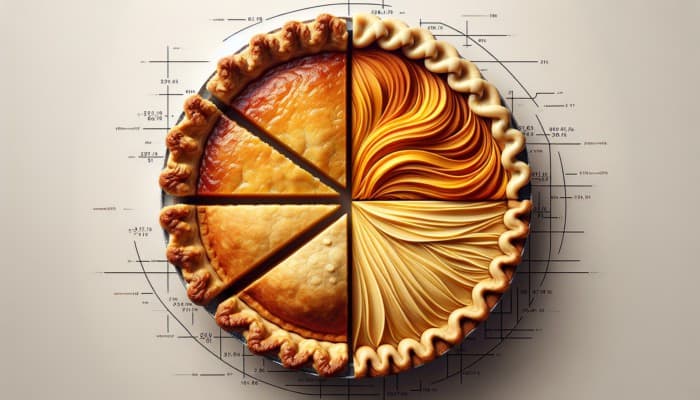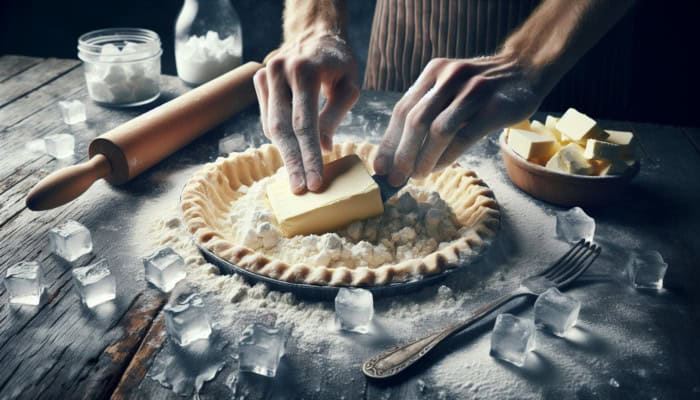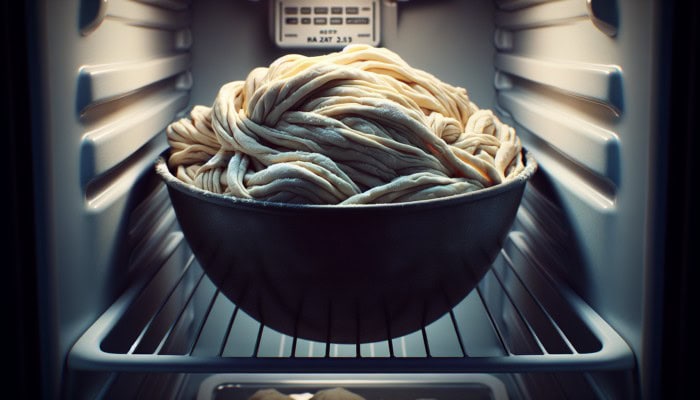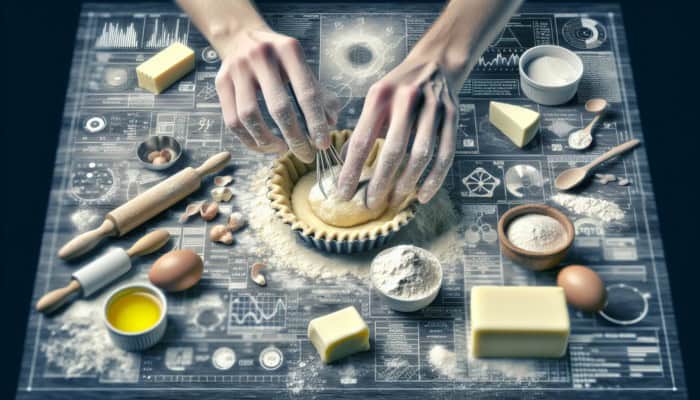Mastering the Art of a Flaky Pie Crust: Selecting the Ideal Fat
Comparing Butter and Shortening for Optimal Flakiness

Secrets to a Flaky Pie Crust: Choosing the right fat is crucial to creating the perfect pie crust. Butter is renowned for its rich flavour and aromatic qualities that elevate the overall taste of your pie. However, it may fail to deliver the flakiness that many bakers seek. In contrast, shortening is highly regarded for its ability to produce a tender, flaky crust, thanks to its unique melting characteristics. For those who want the best of both worlds, consider combining butter and shortening. This blend harnesses the delicious flavour of butter while leveraging the superior flakiness that shortening provides, resulting in a tasty and texturally satisfying crust.
Mixing these fats enhances the flavour and contributes to the crust's structure. The ratio can be personalised, with a 50/50 blend often yielding fantastic results. Remember, though, that the quality of your ingredients plays a significant role. Always opt for high-quality butter with a higher fat content for the best baking outcomes.
Discovering the Unique Benefits of Lard
Though often overlooked in discussions about pie crust fats, lard deserves recognition for its exceptional ability to create a flaky texture. Almost 100% fat, lard produces a crust that is unmatched in lightness and flakiness. This is largely due to the distinct melting point of the fat molecules in lard, which facilitates the formation of multiple layers within the crust, resulting in a wonderfully flaky texture.
Aim to source high-quality leaf lard for the best results when opting for lard. Leaf lard, harvested from the kidney area of pigs, offers a cleaner taste and superior texture compared to regular lard. If you're concerned about the flavour, rest assured that well-sourced lard will not impart any unpleasant taste; instead, it enhances the overall experience of your pie. Many traditional recipes still utilise lard to achieve that much-desired flaky texture, so it’s worth experimenting with if you haven’t tried it yet.
Exploring Vegan Options for Pie Crusts
If you’re seeking plant-based alternatives, you can still create a flaky pie crust that meets your dietary preferences. Coconut oil and vegan butter have emerged as popular substitutes, each offering unique characteristics. While coconut oil can produce a slightly different texture, it still achieves a commendable level of flakiness, especially when maintained at a chill temperature during the mixing process.
It’s important to note that the flavour profile will shift significantly. Coconut oil imparts a subtle coconut flavour, which may or may not align with the type of pie you’re preparing. On the other hand, vegan butter can often be used as a direct substitute for traditional butter, but quality can vary across brands, affecting both flavour and texture.
Experimentation is key when working with these alternatives, as achieving the right balance of taste and texture might take a few tries to perfect. However, with the right techniques, creating a delicious vegan pie crust is entirely achievable, opening the world of baking to everyone, regardless of dietary restrictions.
Mastering the Flaky Pie Crust: Importance of Keeping Ingredients Cold

The Essential Chilling of Fats for Flaky Layers
The texture of your pie crust is intrinsically linked to the temperature of your fats. Keeping your fats cold is fundamental in achieving those irresistible flaky layers. When cold fat is incorporated into the dough, it remains solid during the mixing process, forming pockets of fat within the flour. As the pie bakes, these pockets melt, generating steam that lifts and separates the dough, resulting in a beautifully flaky texture.
The chilling process should extend beyond the fat and keep all ingredients cold. Preve your butter or shortening directly from the fridge to ensure it doesn’t melt into the flour prematurely. This practice is especially important in warmer climates or during the summer months, where temperature control can be challenging.
To maximise flakiness, consider chilling your mixing bowl and utensils as well. These small adjustments can significantly impact the outcome, ensuring your crust achieves the desired texture and consistency that enhances your pie experience.
Why Ice-Cold Water Is Crucial for Your Dough
Another vital component in crafting a flaky pie crust is ice-cold water. The temperature of the water is pivotal in preserving the integrity of the fats throughout the mixing phase. Adding cold water prevents the fat from melting too soon, allowing it to remain distinct within the dough, which is essential for flakiness.
Using ice-cold water also limits gluten development, which can lead to a tougher crust. This is crucial because gluten is beneficial for providing structure in bread, but it can create undesirable chewiness in a pie crust. Using the minimum amount of cold water to bring the dough together is best. If the dough appears dry, you can add water by the teaspoon incrementally until it reaches the desired consistency without overworking it.
This simple yet critical step helps maintain the delicate balance between flakiness and tenderness, ensuring every bite of your pie crust is as delightful as the filling it encases.
Refrigerating Dough: A Key Step for Success

Once you've mixed your dough, the next vital step is refrigerating it. Allowing your dough to rest in the fridge is crucial as it relaxes the gluten strands formed during mixing. This relaxation not only facilitates easier rolling but also enhances the overall texture of your crust.
Aim to chill the dough for at least 30 minutes, although longer durations can yield even better results. This resting period allows the flour to fully hydrate and meld with the fats, resulting in a simpler dough to roll out, less prone to shrinkage during baking, and offering improved flakiness.
Moreover, if you’re not planning to use the dough immediately, it can be frozen later. Wrap it tightly in plastic wrap or a freezer bag to prevent freezer burn. When you’re ready to bake, transfer it to the fridge to thaw overnight.
Chilling and relaxing your dough can profoundly influence the final product, transforming a good pie crust into an exceptional one.
Mastering the Flaky Pie Crust: Effective Mixing Techniques
Techniques for Cutting in Fat for Optimal Flakiness
Incorporating fat into your pie crust is vital for achieving that desirable flakiness. Cutting in the fat, whether it be butter, shortening, or lard, requires careful attention. The objective is to create small, pea-sized pieces of fat throughout the flour. This can be achieved using a pastry cutter, fork, or fingers.
When cutting in the fat, take your time and proceed gently. The goal is to preserve those little bits of fat rather than melt them into the flour. Each piece of fat serves as a barrier to gluten formation, creating pockets that will expand during baking, resulting in an irresistible flaky texture.
If you struggle with this step, consider chilling your utensils to maintain the fat's temperature. This helps ensure that each piece remains intact, contributing to the overall flakiness of your crust. Remember, the art of pie-making lies in the details, and properly cutting in your fat is one of the secrets to achieving a flaky pie crust.
Minimising Dough Handling for Tender Results
Overworking your dough is a common mistake that can lead to a tough, undesirable crust. Once the fat has been incorporated, handling the dough as little as possible is essential. Excessive mixing promotes gluten development, which can cause your pie crust to lose its tender, flaky quality.
When combining the ingredients, mix them just until they come together. The dough should still be slightly shaggy; don’t be alarmed by this. The addition of cold water should be just sufficient to amalgamate the ingredients without extensive handling. This minimalistic approach ensures that your dough remains tender and flaky, allowing it to rise beautifully during baking.
If you encounter difficulty working with the dough, resist the urge to knead it. Instead, allow it time to rest in the fridge. This resting period permits the flour to hydrate fully and the gluten to relax, facilitating easier rolling without compromising texture.
Elevate Your Pie Crust with the Folding Method
The folding method is an exceptional exploration technique for those eager to enhance their pie-crust skills. Like making puff pastry, this approach involves rolling out the dough and folding it over itself multiple times. This process creates layers within the crust that contribute to its flakiness.
Begin by rolling out your dough into a rectangular shape. Next, fold it in thirds, like a letter, before rolling it out again. Repeat this process several times, ensuring the dough remains chilled throughout. Each fold introduces additional layers of fat and flour, which will separate during baking, leading to a beautifully flaky texture.
This technique is particularly advantageous for those wishing to create a more sophisticated pie crust. It enhances both flavour and texture, resulting in a crust that is not only visually appealing but also delectably flaky and tender, making your pie a true standout.
Importance of Chilling All Ingredients
To ensure optimal results, keep every component of your pie crust cold. This practice includes the fats and any liquids you intend to use. Keeping all ingredients chilled will help maintain the integrity of the fats and prevent them from melting prematurely during mixing.
When preparing your ingredients, consider briefly freezing your butter or shortening. Similarly, ice-cold water or chilling your mixing bowl can significantly enhance the process. The colder your ingredients, the better the flakiness of your final crust.
This practice is especially critical during warmer months or in humid environments, where heat can quickly alter the state of your fats. By chilling your ingredients, you can produce a pie crust that is consistently flaky and delicious, regardless of the conditions.
Resting the Dough: A Key to Perfect Pie Crusts
Resting the dough is an essential step that novice bakers often overlook. After mixing your dough, place it in the fridge to rest. This process allows the gluten to relax and the moisture to distribute evenly throughout the dough, making it easier to roll out while improving the final texture.
Aim for a resting time of at least 30 minutes, although you can extend this period if desired. When you’re ready to use the dough, take it out and let it sit for a few minutes at room temperature before rolling it out. This slight warming makes the dough more pliable, facilitating easier handling.
Resting not only enhances the dough's manageability but also improves its flavour. The flour continues to hydrate as the dough sits, contributing to a more cohesive structure. When baked, this results in a flaky and tender crust, providing an ideal complement to any filling.
Mastering the Flaky Pie Crust: The Importance of Flour Type
Utilising All-Purpose Flour for Versatile Baking
Many bakers choose all-purpose flour as their staple because of its versatility in various recipes. While it can adequately work for pie crusts, it may not deliver the tender, flaky results that some aspire to achieve. With a moderate protein content, all-purpose flour can develop gluten, which is beneficial for bread but may lead to a denser pie crust.
Consider adjusting your technique to improve the results if you use all-purpose flour. The key lies in handling the dough minimally and incorporating fat correctly. This way, you can still produce a decent crust, although it may not be as light and flaky as those made with specialised flours.
To elevate the texture, some bakers prefer to blend a small portion of cake flour with all-purpose flour, which can help create a more tender crust while remaining widely accessible.
Choosing Pastry Flour for Superior Flakiness
Pastry flour is an outstanding choice for those serious about achieving an exceptionally flaky pie crust. It produces less gluten and has a lower protein content than all-purpose flour, resulting in a more tender and flaky crust. Specifically designed for pastries, this flour is a favourite among professional bakers.
When working with pastry flour, you may require slightly less liquid than with all-purpose flour. This is because pastry flour absorbs moisture differently. A good rule of thumb is to start with the same amount of water and adjust as necessary, ensuring that your dough remains manageable and easy to work with.
Opting for pastry flour can elevate your pie crust, leading to a lighter, more delicate texture that beautifully complements a variety of fillings, enhancing the overall pie experience.
Incorporating Cake Flour for Enhanced Tenderness
Integrating cake flour into your chosen flour can add a layer of finesse to your pie crust. With its fine texture and low protein content, cake flour enhances tenderness and flakiness, turning your crust into a standout pie feature.
Typically, a blend of half all-purpose flour and half cake flour yields excellent results. This mixture balances structure and tenderness, allowing for the best of both worlds. The fine texture of cake flour contributes to a lighter crust that is still robust enough to hold fillings without buckling.
This method is particularly effective for fruit pies, where a delicate crust can elevate the dish. By incorporating cake flour, you ensure each bite melts in your mouth while providing the necessary support for your fillings.
Avoiding Bread Flour for Pie Crusts
While bread flour is typically associated with yeasted goods, its higher protein content can produce a chewier texture when used in pie crusts. This is not ideal, as the goal is to achieve a flaky and tender crust. Using bread flour can result in a tougher pie crust that detracts from the overall experience.
If bread flour is your only option, consider mixing it in smaller proportions with all-purpose flour to mitigate the effects of gluten development. However, for the best results, stick with flours that are more suitable for pastry-making, such as all-purpose, pastry, or cake flour.
Selecting the right type of flour is critical in pie-making. While experimentation can be enjoyable, understanding each flour's properties will help you achieve the perfect flaky pie crust.
Whole Wheat Flour: A Nutty Twist for Your Pie Crust
Whole wheat flour adds a distinct nutty flavour and nutritional benefits to your pie crust. However, it’s important to be aware that it can also create a denser texture, which may not be ideal for all pies. The bran and germ in whole wheat flour can inhibit gluten development, potentially resulting in a crust that doesn’t rise as beautifully.
If you wish to incorporate wholewheat flour into your pie crust, consider blending it with all-purpose or pastry flour. A 50% mix of whole wheat flour and 50% all-purpose flour can strike a balance, adding flavour without sacrificing flakiness.
This approach works particularly well for rustic pies, where the robust flavour of whole wheat flour complements hearty fillings. Embracing whole wheat flour can enhance the taste and contribute to a more nutritious pie, appealing to health-conscious bakers.
Mastering the Flaky Pie Crust: Perfecting Rolling and Shaping Techniques
Achieving Even Thickness for Consistent Baking
Obtaining a consistent thickness when rolling out your pie crust ensures even baking. An unevenly rolled crust can result in hot spots that either overcook or undercook during baking. To ensure uniformity, begin from the centre and work outward, rotating the dough as you go.
Utilising a rolling pin with guides can assist you in maintaining an even thickness, typically around 1/8 inch thick. This allows the crust to bake uniformly while providing sufficient structure to support the filling. If you notice any thinner areas, you can gently patch them with excess dough, ensuring a uniform surface.
Equally important is the surface on which you roll. A lightly floured surface can help prevent sticking, but be cautious not to overload the dough with flour, which may lead to a drier crust. Keeping the dough chilled while rolling also aids in achieving the perfect thickness while preserving its integrity.
Minimising Over-Rolling to Preserve Flakiness
While it may be tempting to roll out your dough repeatedly for perfection, over-rolling can lead to tough crusts. Each time you roll out the dough, you risk developing gluten, compromising the desired flakiness. Limit re-rolling to an absolute minimum and work with the dough efficiently to reduce handling.
As a general guideline, once you've rolled it out and placed it in your pie dish, avoid rolling it again unless necessary. If you find the dough difficult to manage, consider taking a break and refrigerating it for a few minutes before attempting again.
A gentle hand and careful touch are your best allies when rolling out pie dough. Treat it with respect, and it will reward you with a flaky, tender crust that’s simply irresistible.
Perfecting the Crimping Technique for a Beautiful Finish
Crimping the edges of your pie crust serves as a decorative touch and has a practical purpose. Properly crimped edges seal in the filling and prevent juices from leaking during baking. This ensures your pie maintains its integrity and presents beautifully when served.
You can use your fingers or a fork to crimp effectively. Pinch the edges together using your fingers to create a wave-like pattern for an appealing finish. If you prefer a fork, press down along the edges for a classic look.
Regardless of your chosen method, ensure the crust is well-sealed to prevent steam from escaping, as this can lead to a dry filling. A well-crimped pie looks impressive and guarantees that every slice retains its moisture and flavour, enhancing the overall pie-eating experience.
Mastering the Flaky Pie Crust: Essential Blind Baking Tips
Utilising Pie Weights for Flawless Blind Baking
Blind baking is a technique that guarantees your pie crust is perfectly cooked before adding the filling. One of the most effective ways to achieve this is pie weights. These weights help prevent the crust from puffing up and losing shape during baking.
To blind bake effectively, line your pie crust with parchment paper and fill it with pie weights or dried beans. This weight keeps the crust flat and stable, allowing for even cooking. After a brief baking period, remove the weights and parchment, then allow the crust to continue baking until lightly golden.
A common mistake is skipping pie weights, often resulting in a crust that puffs or bubbles. Investing in quality pie weights or even improvising with dried beans can significantly enhance the success of your blind baking efforts, ensuring a perfectly cooked crust.
Understanding the Importance of Docking the Dough
Docking your dough is a straightforward technique that involves pricking the bottom of the crust with a fork before baking. This process allows steam to escape, preventing air bubbles from forming that could disrupt the crust's surface.
Docking is particularly critical for custard or cream pies, where a smooth surface is essential for aesthetics and texture. Be sure to dock evenly across the surface to ensure consistent cooking. While this may seem minor, it plays a vital role in achieving a beautifully baked pie crust.
If you neglect this step, you may end up with a crust that has developed unsightly bubbles, detracting from the overall presentation of your pie. Take the time to dock your dough, which will pay off in the final product.
Deciding Between Partial and Full Baking Techniques
Understanding when to fully or partially bake your crust is crucial for pie success. A partial bake is often sufficient for fruit pies or those with wet fillings. This method allows the crust to develop a base without becoming overly brown before adding the filling.
Conversely, for recipes that require wet fillings, such as custard pies, a fully baked crust is necessary to ensure the filling cooks properly. A fully baked crust should be golden and crisp, providing a stable base for the filling without becoming soggy.
Knowing the difference between partial and complete baking can dramatically affect the quality of your pie. Always refer to specific recipe instructions to determine the best approach for your pie crust, ensuring optimal results every time.
Mastering the Flaky Pie Crust: Baking Temperature and Timing
Starting with High Heat for Optimal Flakiness
Initially, baking at a high temperature is a proven strategy for achieving a crisp, flaky crust. Starting your pie at around 220°C (425°F), you help set the structure before reducing the temperature. This initial burst of heat causes the water in the fat to turn to steam, creating those beautiful layers essential for flakiness.
Once the crust sets, you can lower the temperature to around 180°C (350°F) to finish baking the pie. This two-step approach allows for a perfectly cooked crust that balances browning with tenderness, resulting in an impressive pie.
Keep a close eye on your pie during the baking process. Although the enticing aroma of baking pastries can be distracting, don’t let it divert your attention from monitoring the colour and texture of your crust closely.
Monitoring Your Pie Crust for Perfect Doneness
Understanding how to assess the doneness of your pie crust is essential for achieving the perfect bake. The crust should be a lovely golden brown, indicating that it has cooked through adequately. A crust that appears too pale suggests it may be undercooked, whereas a dark, almost burnt appearance indicates it’s overbaked.
Texture is equally crucial; a flaky crust should feel crisp without signs of sogginess. If you notice damp spots, additional baking time may be required. Consider using an instant-read thermometer to measure the internal temperature; it should read around 93°C (200°F) for a fully baked crust that is both delicious and satisfying.
Assess your pie regularly during the baking process to ensure that it reaches the sweet spot of doneness, elevating your pie-baking skills to new heights.
Cooling Your Pie for Optimal Flakiness
Once your pie has come out of the oven, it is crucial to allow it to cool properly. This enables the filling to set and the flavours to meld and contributes to the crust's flakiness. If you slice into a still-hot pie, you risk it collapsing, leading to an unappealing presentation.
Place your pie on a wire rack to cool for at least 1 hour before serving. This airflow helps the crust maintain its crispness, preventing it from becoming soggy. Cooling also allows the filling time to thicken, ensuring each slice holds its shape beautifully.
Patience is truly a virtue when it comes to cooling pies; allowing them to rest before serving enhances appearance and flavour, making a significant difference for your guests.
Frequently Asked Questions about Pie Crust Mastery
What is the best fat for a flaky pie crust?
The ideal fats for creating a flaky pie crust are typically butter and shortening. Butter enhances flavour, while shortening contributes to flakiness. Some bakers also prefer lard for its exceptional flakiness.
How can I prevent my pie crust from becoming soggy?
To avoid a soggy pie crust, blind bake it before adding the filling. Utilising pie weights and ensuring that your crust is fully baked will also help maintain its texture and prevent sogginess.
Is it possible to use whole wheat flour for a pie crust?
Yes, whole wheat flour can be used for a pie crust, but it may create a denser texture. It’s advisable to mix it with all-purpose flour for better flavour and flakiness.
How long should I chill my pie dough?
Chill your pie dough for at least 30 minutes; longer chilling times can further enhance texture and handling, resulting in better final results.
What purpose does docking the dough serve?
Docking the dough involves pricking it with a fork to allow steam to escape during baking. This prevents air bubbles and ensures an even bake that enhances the overall appearance.
Should I use ice-cold water in my pie crust?
Yes, incorporating ice-cold water helps maintain the temperature of the fats, preventing them from melting too soon and contributing to a flaky texture vital for successful pie crusts.
Can I freeze pie crust dough for later use?
Absolutely! You can freeze pie crust dough for up to three months. To prevent freezer burn, wrap it tightly in plastic wrap and place it in a freezer bag.
How do I know when my pie crust is perfectly done?
A perfectly baked pie crust should be golden brown and crisp. For optimal doneness, use an instant-read thermometer to check that the internal temperature reaches around 93°C (200°F).
What is the folding method for pie crusts?
The folding method involves rolling out the dough and folding it over multiple times to create layers, enhancing flakiness, like the puff pastry preparation technique.
What type of flour is best for pie crusts?
Pastry flour is ideal for pie crusts due to its low protein content, which results in a more tender and flaky crust. Mixing in cake flour can also enhance tenderness, providing a delightful texture.



Your exploration of fat choices for pie crust truly highlights the nuances in baking that often get overlooked. I agree that butter brings an unparalleled depth of flavor, but I’ve found that using all butter can sometimes lead to a crust that’s just too crispy instead of flaky. The introduction of shortening is a game changer in that regard.
I completely relate to your experience with pie crusts. It’s fascinating how the choice of fat can really shift the texture and flavor profile of the final product. I’ve noticed similar issues when using all butter—while it has that amazing richness, it can sometimes lack the tenderness that a flaky crust should have.
You hit the nail on the head with your observations about fat in pie crusts. Isn’t it interesting how a seemingly small choice can completely change the outcome? All butter can create that rich, luxurious flavor, which definitely makes it a crowd-pleaser. But like you mentioned, it can come with a trade-off in terms of tenderness.
You’ve hit on something really interesting with the fat choice—it’s often one of the most underrated aspects of baking. I’ve had my fair share of battles with pie crusts, and the differences between using all butter versus a mix of fats can be pretty wild. It’s almost like creating a balancing act; the richness of butter gives such a fantastic flavor, but you’re right, it can easily skew the texture if you’re not careful.
You make a great point about the balancing act of achieving the perfect crust. I’ve often found that too much butter can indeed lead to that overly crispy texture you mentioned, which can be a bit disappointing when I’m aiming for that lovely, tender flakiness.
I appreciate your take on fat choices in baking; speaking of classic techniques, I recently came across a great guide on preparing Beef Wellington that dives into the nuances of creating the perfect pastry around that delicious filling.
‘How to Cook a Classic Beef Wellington: A Timeless Recipe’
https://cookinggods.com/how-to-cook-a-classic-beef-wellington-a-timeless-recipe/.
Your experience with butter in baking resonates with so many home cooks. Finding that right balance can be tricky, especially when you want that tender, flaky texture to shine through. It’s all about the method, isn’t it? Cold butter and minimal mixing can help maintain those beautiful layers while keeping things lighter.
I appreciate your perspective on the fat choices for pie crust. It’s interesting how personal experiences shape our baking methods, and I completely resonate with your thoughts on the balance between flavor and texture. Butter does bring that delightful richness to a crust, but I understand what you mean about it sometimes tipping the scales toward overly crispy.
Your insights on the importance of fat in crafting a flaky pie crust are both practical and enlightening. I appreciate how you distinguish between butter and shortening, highlighting their unique contributions to texture and flavor. I have long been a proponent of using butter for its incomparable flavor profile, particularly in fruit pies where the natural sweetness of ingredients can really shine. However, I have also encountered challenges with achieving the ideal flakiness that many pie lovers appreciate.
It’s great to hear your take on butter versus shortening! You’re spot on about butter bringing that rich flavor, especially in fruit pies. It really does something magical when you combine it with sweet, juicy fruits. There’s just no substitute for that buttery taste, and it can elevate the entire dessert.
It’s great to hear your perspective on using butter for pie crusts, especially with fruit pies where that rich flavor can make a real difference. I can understand the desire to balance flavor with texture—getting that ideal flakiness can sometimes feel elusive.
I’m glad you found the insights helpful! If you’re interested in exploring tips and techniques to enhance that perfect flaky texture while maintaining the delightful flavor of butter, check out this resource that dives deeper into pie crust mastery.
http://cookinggods.com/KetoBreads
This is such a delightful exploration of the nuances involved in creating a perfect pie crust! I’ve often found myself immersed in the debate over butter versus shortening, and it seems like a topic that resonates deeply with many bakers. Personally, I grew up watching my grandmother craft her pies, and she swore by an all-butter recipe. While the flavor was undeniably rich and nostalgic, I often found myself wishing for that flaky texture that can sometimes elude even the most skilled hands.
It’s so interesting how our experiences with baking shape what we prefer, isn’t it? Your memories of your grandmother making pies with that all-butter recipe really capture the warmth and comfort of baking traditions. I totally get the flavor aspect; butter definitely delivers that richness that’s hard to beat.
It’s fascinating how food memories, like those pie-baking moments with your grandmother, can shape our preferences and approaches in the kitchen. You really capture the essence of that butter versus shortening debate that many bakers find themselves caught up in. The choice between the two certainly involves a blend of nostalgia and technique.
“I’m so glad you enjoyed the article! If you’re looking to perfect that flaky texture while still embracing that rich flavor, check out this resource I found that dives deeper into the butter versus shortening debate.”
https://cookinggods.com/DigestiveHealth
Ah, the great butter versus shortening debate! It’s like choosing between two beloved family members: one bakes cookies with a hug and the other makes the crispiest fried chicken. I have to confess, I’ve spent way too many evenings standing in front of my fridge, staring at my butter and shortening like a contestant on a cooking show trying to decide who should go home first.